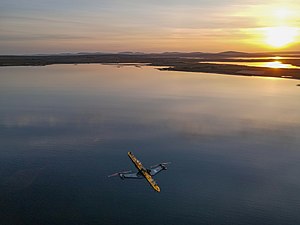| Orbital O2 | |
|---|---|
 | |
|
| |
| Country | Scotland |
| Location | Fall of Warness, Orkney Islands |
| Coordinates | 59°8′39.48″N 2°48′55.68″W / 59.1443000°N 2.8154667°W |
| Status | Active |
| Construction began | 2019 |
| Commission date | 2021 |
| Owner(s) | Orbital Marine Power |
| Tidal power station | |
| Type | Tidal stream generator |
| Type of TSG | Floating, twin horizontal-axis rotors |
| Crosses | Fall of Warness |
| Power generation | |
| Units operational | 1 × 2 MW |
| Units planned | 3 × 2.4 MW |
Orbital Marine Power (formerly Scotrenewables Tidal Power Ltd) is a Scottish renewable energy company focused on the development and global deployment of its pioneering floating turbine technology. The O2 is Orbital's first commercial turbine and represents the culmination of more than 15 years of world leading product development in the UK. The 74 m long turbine is expected to operate in the waters off Orkney for the next 15–20 years with the capacity to meet the annual electricity demand of around 2,000 UK homes with clean, predictable power from the fast-flowing waters while offsetting approximately 2,200 tonnes of CO2 production per year. In a further ground-breaking element of the project, the O2 will provide power to the European Marine Energy Centre's onshore electrolyser to generate green hydrogen that will be used to demonstrate decarbonisation of wider energy requirements.
As of 28 July 2021 [update], it is the most powerful tidal turbine in the world and is anchored in the Fall of Warness off Eday, Orkney Islands.
History
Scotrenewables Tidal Power was founded in Orkney 2002 to develop the floating tidal stream turbines. The company was rebranded as Orbital Marine Power in 2019, alongside a crowdfunding campaign that raised £7m towards constructing their first commercial turbine, the O2. [1] [2] The company has built and tested three versions of their floating tidal turbines, the SR250, SR2000, and the O2.
SR250
Orbital (then called Scotrenewables) was the first company in the world to successfully grid connect a floating tidal turbine, the SR250. This was a 250 kW rated machine, with twin contra-rotating 8 m diameter two-bladed rotors. These were mounted either side of the hull on 'rotor legs' that could be raised to limit draft when towing. The buoyant hull was a 34 m long, 2.3 m diameter tube. The device weighed 100 tonnes and was anchored by four catenary moorings via a quick connect turret on the hull tube. [3] The rated current speed was 2.5 m/s (4.9 knots, 5.6 mph).
The SR250 was constructed by Harland & Wolff in Belfast in 2010, being launched early in 2011 and towed to the European Marine Energy Centre in Orkney. [4] Initial tests were performed by towing the device through the water, achieving peak power for the first time in December 2011. [5] The device was connected to the Orkney electricity grid in 2012. [6]
SR2000

In 2016 the company launched the SR2000, the world's most powerful tidal stream turbine, at 2 MW. The SR2000 produced in excess of 3 GWh of electricity over its initial 12-month continuous test programme. At the time this represented more power from a single turbine than had been generated cumulatively by the wave and tidal sector in Scotland over the 12 years prior to the launch of the SR2000. [1]
The SR2000 was also constructed by Harland & Wolff in Belfast, launched on 12 May 2016. [7] This turbine had twin 16 m diameter rotors, a 63 m long hull, and weighed 550 tonnes. [6] It first exported power to the grid in October 2016, and was tested until September 2018. The turbine was towed to Blyth, Northumberland for decommissioning by Thompsons of Prudhoe. [8]
O2

The Orbital O2 was constructed in Dundee, Scotland [9] [10] by Texo Group. [11] The hull was produced by Grey Fabrication in Cupar, [12] and the four composite blades were manufactured by A C Marine & Composites (ACMC) in Gosport. [13]
It was launched from the city into the Tay Estuary on 22 April 2021 via a submersible barge. This turbine has twin 20 m diameter rotors, a 72 m long hull, and weighs 680 tonnes. [14] It was towed to the Fall of Warness site in April and grid connected in July 2021. [6]
Features
- The O2 incorporates key innovations and lessons from the company's previous prototype, the SR2000, that, on a like-for-like basis, enable a 35% improvement in yield.
- Rotor diameters of 20m.
- 600sq metre rotor area, the largest ever on a single tidal generating platform to date.
- 360 degree blade pitching control, for safe, dynamic control of the O2's rotors, enabling power to be captured from both tidal directions without need to yaw the entire platform.
- The floating structure is held on station with a four-point mooring system where each mooring chain has the capacity to lift over 50 double decker buses. Electricity is transferred from the turbine via a dynamic cable to the seabed and a static cable along the seabed to the local onshore electricity network.
Future deployments
In July 2022, Orbital were awarded contracts for 4.8 MW and 2.4 MW in the UK Contracts for Difference (CfD) AR4 auction, to supply electricity from turbines at Eday from 2026/27. [15] In September 2023, they were awarded a further 4.8 MW plus 2.4 MW, to be commissioned in 2027/28. [16] This equates to a pipeline of six further O2 turbines. Orbital announced in October 2023 they were successful in applying for the Horizon Europe sustainable tidal farms call, and would be leading the EURO-TIDES project to develop a 9.6 MW array. [17]
Orbital have also secured an option agreement from Crown Estate Scotland and a grid connection for a 30 MW array to be constructed in the Westray Firth, to the north of the existing O2 deployment. [18]
Plans have also been announced to deploy a next-generation 2.4 MW O2X turbine at the Fundy Ocean Research Centre for Energy (FORCE), located in the Bay of Fundy. This would be in partnership with project developer Eauclaire Tidal. [19]
Orbital previously announced in 2018 that they planned to deploy their floating 2 MW Orbital O2 turbines at the Morlais site in Wales. [20]
External links
References
- ^ a b "Orbital Marine Power going with the ebb and flow". The Herald. 2019-04-30. Retrieved 2023-12-03.
- ^ "Press release: Orbital Marine Power raise £7 million through crowdfunding : EMEC: European Marine Energy Centre". Retrieved 2023-12-03.
- ^ "Scotrenewables Tidal Power Ltd SR250 Deployment Fall of Warness: Environmental Statement Volume I - Environmental Statement | Tethys". tethys.pnnl.gov. Retrieved 2023-12-03.
- ^ "Harland and Wolff - Shipbuilding and Engineering Works". www.theyard.info. Retrieved 2023-12-03.
- ^ annevisser (2011-12-20). "Scotrenewables' SR250 Achieves Full Power of 250kW (UK)". Offshore Wind. Retrieved 2023-12-03.
- ^ a b c "Orbital Marine Power : EMEC: European Marine Energy Centre". Retrieved 2023-12-03.
- ^ "Scotrenewables SR2000 Tidal Turbine". Harland & Wolff. Retrieved 2023-12-03.
- ^ "Orbital decommissions SR2000 tidal turbine". renews.biz. 2021-08-12.
- ^ "Orbital Marine Power Launches O2: World's Most Powerful Tidal Turbine". Orbital Marine. 2021-04-22. Retrieved 2021-11-17.
- ^ Thurston, Alban (2021-04-14). "'Jam, jute and joules': Dundee-built world's most powerful tidal turbine set for grid-linked Orkneys operation". theenergyst.com. Retrieved 2021-11-17.
- ^ "Press release: Orbital O2 to be built by TEXO Group in Dundee : EMEC: European Marine Energy Centre". Retrieved 2021-11-17.
- ^ McLaren, Rob (2021-04-23). "Stunning pictures show launch of first vessel from Dundee in 40 years". The Courier. Retrieved 2024-02-07.
- ^ "ACMC to Build Tidal Blades for Orbital O2 Turbine". Offshore Energy. 2019-11-28. Retrieved 2024-02-07.
- ^ Largue, Pamela (2021-04-23). "Orbital Marine Power launches the O2 tidal turbine". Power Engineering International. Retrieved 2023-12-03.
- ^ "Contracts for Difference (CfD) Allocation Round 4: results". GOV.UK. Retrieved 2023-12-03.
- ^ "Contracts for Difference (CfD) Allocation Round 5: results". GOV.UK. Retrieved 2023-12-03.
- ^ Habibic, Ajsa (2023-10-25). "Orbital Marine Power to head multi-turbine tidal energy project". Offshore Energy. Retrieved 2023-12-03.
- ^ newsroom (2023-03-22). "New tidal energy projected revealed by Orbital Marine". The Orcadian Online. Retrieved 2023-12-03.
- ^ Dykes, Andrew (2023-12-05). "Orbital Marine to help unlock Canadian tidal stream project". Energy Voice. Retrieved 2023-12-06.
- ^ Husseini, Talal (2018-12-05). "Orbital Marine Power to demonstrate floating tidal technology at Morlais". Power Technology. Retrieved 2023-11-28.
